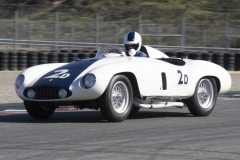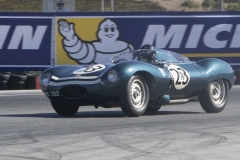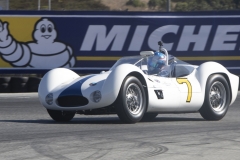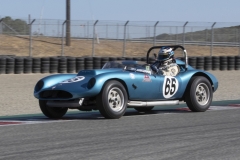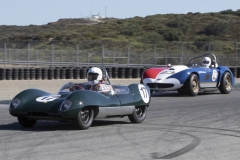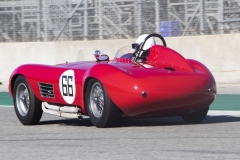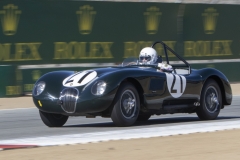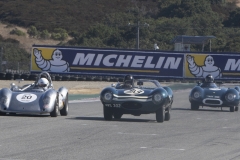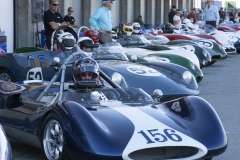When Sex Was Safe…

Story: Tom Stahler – Photos: Adam Hosey
On Saturday morning they came out of the coastal mist like a bolt of lighting from history… For a brief shining moment, it was 1961 again… When sex was safe and racing was dangerous.
The songs of forty-three mid to late 1950’s sports racing cars, each with their individual notes made a symphony of roars. Ferrari, Jaguar, Lotus, Maserati, Lister, Cooper, Porsche, Elva — all period correct down to the treaded “skinny” tires which screeched around corners, struggling for traction. Many of these cars are virtually priceless, but to the delight of fans and enthusiasts, the owners graciously continue to run these cars in anger.
Laguna Seca Raceway in Monterey, built originally in 1957, plays host to the world famous Rolex Monterey Reunion. Every August amongst the sensory overload that is Monterey Car Week, full of auctions, races, shows and the famed Pebble Beach Concours de Elegance was this little corner — a particular category of cars that raced on the world’s great circuits while the other cars in this magazine motored along the streets, roads and highways of America.
This race group, simply called 2A, is a cluster of sports racing cars from 1955 to 1961, both over and under 2000cc. Considering that era of daring-do, it is wonderful to be transported back in time to see these cars in action. Few, if any drivers who originally turned those wheels are alive today, but their sweat and grit remain as the cars race on.
Several high-profile events like this one are played out around the world at places like Goodwood, Hockenheim, LeMans, Monaco and Indianapolis. Historic racing, as a hobby, has a storied history as most race cars are usually viable for a short period of time in the tightly competitive sanctions and clubs, but live on and continue to be competitive in race groups like this one. More than eight different groups took to the track over the course of the weekend, practicing, qualifying and racing.
For the drivers, the experience is a trip back in time as well. The technology was much simpler. Certainly there were always go-fast tricks applied to many of the cars, however in this particular era, aerodynamics were an afterthought, for example. Numerous home build sports racing cars, with lightweight bodies and big engines were thought to be the winning combination. Not unlike the road cars of the day, horsepower was key. Cars like the Echidna and Sorrell-Larkin Special were garage built racers with very limited runs. All three Echidnas, built in the late-1950s were reunited at this event.
Then there were the factory cars. Purpose built, lightweight racing cars like the Ferrari TR 250 and 750 Monza; Jaguar C and D-Types; and the Porsche 550 Spyder. One such 550 was crashed and then was rebuilt in a home garage — changing the bodywork to a more “wedge-styled” nose. This Porsche Durlite MkIII was very successful — it would be many years later that tests in a wind tunnel proved that the aerodynamics of the car were far superior to that of the factory racers.
In the early 1950’s, many of these cars might as well been spaceships from Mars. Races drew huge crowds. They first competed on public roads in sleepy resort towns like Watkins Glen, New York; Elkhart Lake, Wisconsin; and Pebble Beach, California. Hay bales and snow fence separated the crowds from the action — and sadly a few spectator fatalities led to a nationwide ban of such races.
Sports Car Club of America member and racer, General Curtis LeMay saved American racing by opening up Strategic Air Command bases to the competitions. In the meantime, those resort towns, no longer enjoying the benefits of racing events, gathered resources and built famed circuits such as Watkins Glen, Road America and Laguna Seca. Thankfully the crowds returned to these great facilities and even today host big time motorsports from all over the world.
Group 2A takes us back to a simpler time — albeit a much more dangerous time in racing. Historic Racing Clubs such as HMSA, FIA, SVRA, VARA and many others keep the opportunities open for enthusiasts to drive and view these and many other wonderful creations. Plan an outing. You might just catch the bug.

